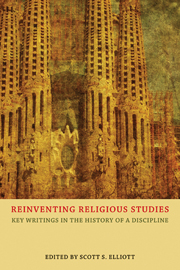Book contents
- Frontmatter
- Contents
- Introduction
- 1 For such a time as this: the Council of Societies for the Study of Religion, 1969–2009
- Part I Inventing and reinventing the field of religious studies
- Part II Method and theory in religious studies
- Part III Teaching religion
- Part IV Women and the bible in religious studies
- Part V Religion and religious studies in civic life
- 24 Contemporary socio-political change and the work of religious studies
- 25 The scholar of religion as a cultural critic: perspectives from Denmark
- 26 What are the humanities and why do they matter? The case of religion and public life
- 27 Response to Gary Lease's “What are the humanities, and why do they matter?”
- 28 So, what are we professing here? Religion, the liberal arts, and civic life
- 29 Response to Raymond B. Williams's “So, what are we professing here? Religion, the liberal arts, and civic life”
- 30 Response to Raymond B. Williams's “So, what are we professing here? Religion, the liberal arts, and civic life”
- 31 Response to Raymond B. Williams's “So, what are we professing here? Religion, the liberal arts, and civic life”
- 32 Rejoinder
- Part VI Religious studies and identity politics
- Part VII Islam and 9/11
- Bibliography
- Acknowledgments
- Index
24 - Contemporary socio-political change and the work of religious studies
from Part V - Religion and religious studies in civic life
- Frontmatter
- Contents
- Introduction
- 1 For such a time as this: the Council of Societies for the Study of Religion, 1969–2009
- Part I Inventing and reinventing the field of religious studies
- Part II Method and theory in religious studies
- Part III Teaching religion
- Part IV Women and the bible in religious studies
- Part V Religion and religious studies in civic life
- 24 Contemporary socio-political change and the work of religious studies
- 25 The scholar of religion as a cultural critic: perspectives from Denmark
- 26 What are the humanities and why do they matter? The case of religion and public life
- 27 Response to Gary Lease's “What are the humanities, and why do they matter?”
- 28 So, what are we professing here? Religion, the liberal arts, and civic life
- 29 Response to Raymond B. Williams's “So, what are we professing here? Religion, the liberal arts, and civic life”
- 30 Response to Raymond B. Williams's “So, what are we professing here? Religion, the liberal arts, and civic life”
- 31 Response to Raymond B. Williams's “So, what are we professing here? Religion, the liberal arts, and civic life”
- 32 Rejoinder
- Part VI Religious studies and identity politics
- Part VII Islam and 9/11
- Bibliography
- Acknowledgments
- Index
Summary
When he was teaching in Union Theological Seminary in New York, Reinhold Niebuhr enjoyed admonishing his students that the two source materials which were absolutely indispensable to their work were the Holy Bible and The New York Times. He urged them to cultivate the art of reading both of these documents together, at regular intervals, and in light of each other. For, in his view, The New York Times lends access to the subjects most fundamental to the Bible, on which it also provides explicit daily commentary. And the Holy Bible brings a greater depth and richer perspective to the issues documented within the daily newspaper. The interaction between these two source materials, in Niebuhr's view, brings substance and creativity to theological work.
In citing Niebuhr's admonition, I am fully cognizant that I am borrowing an example from theology to talk about the composition of religious studies. And I am acutely aware of the fact that the two enterprises are not the same. They do not carry the same intentions. They are not conceived according to the same conceptual or intentional models.
And yet the example does enable me to raise, I think, some important questions. How might the composition of religious studies be affected if the contents of, say, The New York Times, 60 Minutes, Issues and Answers, or The Los Angeles Times were brought more closely to its fundamental ranges of concern? Put more directly, how would religious studies be conducted if such matters were understood to be its proper subject?
- Type
- Chapter
- Information
- Reinventing Religious StudiesKey Writings in the History of a Discipline, pp. 155 - 159Publisher: Acumen PublishingPrint publication year: 2013



